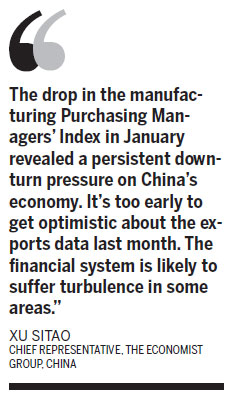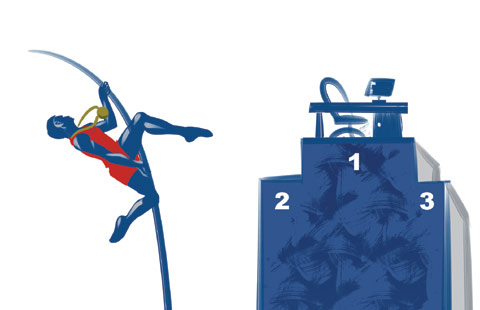Financial turbulence but no crisis in markets: Expert
Updated: 2014-02-18 07:16
By Li Jiabao (China Daily)
|
||||||||
Hong Kong-headquartered Credit Lyonnais Securities, one of the region's largest and most highly rated independent equity brokers and financial-services groups, which focuses on providing broking, investment banking and asset management services to corporate and institutional clients around the world, is paying close attention to the situation. Its chief equity strategist Christopher Wood said if there is a total bailout - or perhaps even worse a bailout through the backdoor as some speculate - it will be a signal that the government's talk of pursuing reform is perhaps not genuine. This will increase macro risks, at a time when China's trust assets now total more than 10 trillion yuan.

According to market estimates, around 5 trillion yuan of trust products mature this year with a peak of around 1 trillion yuan in May.
The Intelligence Unit of The Economist downgraded China's gross domestic product growth forecast to 7.2 percent this year from a previously reported 7.3 percent because the need to curb credit growth poses risks to the growth outlook. China's GDP expanded 7.7 percent in 2013, the same pace as in 2012, which was the slowest since 1999.
"The drop in the manufacturing Purchasing Managers' Index in January revealed a persistent downward pressure on China's economy. It's too early to get optimistic about the export data last month. The financial system is likely to suffer turbulence in some areas," Xu said.
He added the 7.2-percent GDP growth forecast for the world's second-largest economy is neither a bad thing nor a signal of a hard economic landing, but a necessary route for economic rebalancing and advancing reforms.
"China should learn to get relaxed about slowing economic growth and step up reforms in financial sectors," Xu said. "Personally I hope the local currency will slightly devalue to develop some opportunities for exporters and create a better external environment for reforms at home."
He added the tapering of quantitative easing (printing more dollars) in the United States hit China's external environment for advancing domestic reforms, while US economic improvement, which features "jobless recovery", would not boost consumption or increase demand for Chinese exports.
Zhu Haibin, J.P. Morgan China Chief Economist, said the growth momentum has softened from the latest peak of the third quarter of 2013 and the slowdown is mainly driven by the shift of policy priority toward structural reform (from stabilizing growth), the tighter rules on local government expenditure (related to anti-corruption) and the continuation of "credit tapering".
"New sources of growth may emerge as structural reforms move forward (for example liberalizing private investment, supporting the service sector and easing the one-child policy), but the positive impact may come with a delay. Therefore, in the near term, the balance between structural reforms and downside risks (both on the economic and financial sides) remains the biggest the challenge for policymakers," Zhu said.
 |
 |

 Hijacker held after diverting Ethiopian jet
Hijacker held after diverting Ethiopian jet
 Building collapse at Korean resort kills 10
Building collapse at Korean resort kills 10
 The big ballet stage
The big ballet stage
 17 more cement plants biting the dust
17 more cement plants biting the dust
 World's largest freshwater lake frozen
World's largest freshwater lake frozen
 American photographer wins World Press Photo 2013
American photographer wins World Press Photo 2013
 Zhou Yang retains women's 1500m title
Zhou Yang retains women's 1500m title
 Renzi set to become Italy's youngest PM
Renzi set to become Italy's youngest PM
Most Viewed
Editor's Picks

|

|

|

|

|

|
Today's Top News
Envoy begins four-day visit to DPRK
Hainan boosts tourism to Xisha
Policeman gets death sentence for shooting
Woman claims legislator is her child's father
Beijing calls on Tokyo to return plutonium to US
Xi calls on leaders to carry out new reforms
Trade inquiry creates friction
Bigger Chinese role in the Arctic
US Weekly

|

|





